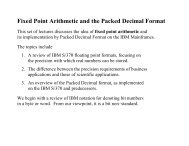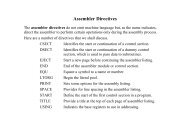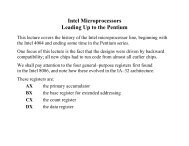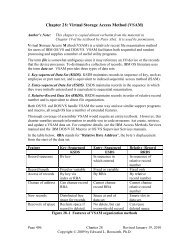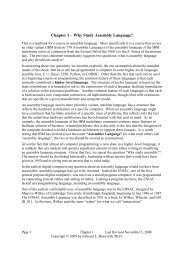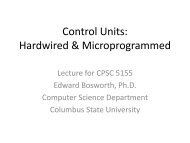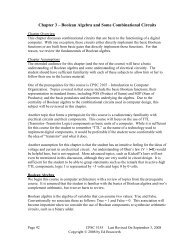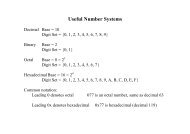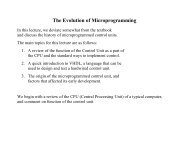Adobe PDF - Edwardbosworth.com
Adobe PDF - Edwardbosworth.com
Adobe PDF - Edwardbosworth.com
You also want an ePaper? Increase the reach of your titles
YUMPU automatically turns print PDFs into web optimized ePapers that Google loves.
Chapter 15 Boz–7 Implementation of the CPU<br />
The control signals for the GET assembly language instruction, as implemented in the<br />
hardwired control unit are shown below. Note that (F, T3) here does nothing as the<br />
instruction cannot be <strong>com</strong>pleted in Fetch and I decided not to make the (F, T3) signal<br />
generation tree more <strong>com</strong>plex when I could force the execution into (E, T0) and (E, T2).<br />
GET Op-Code = 01000 (Hexadecimal 0x08)<br />
F, T0: PC B1, tra1, B3 MAR, READ. // MAR (PC)<br />
F, T1: PC B1, 1 B2, add, B3 PC. // PC (PC) + 1<br />
F, T2: MBR B2, tra2, B3 IR. // IR (MBR)<br />
F, T3: NOP.<br />
E, T0: IR B1, tra1, B3 IOA. // Send out the I/O address<br />
E, T1: WAIT.<br />
E, T2: IOD B2, tra2, B3 R. // Get the results.<br />
E, T3: NOP.<br />
Noting that the NOP microoperations in this sequence are used only because there is nothing<br />
that can be done during those clock pulses, we can rewrite the sequence as follows.<br />
GET Op-Code = 01000 (Hexadecimal 0x08)<br />
T0: PC B1, tra1, B3 MAR, READ. // MAR (PC)<br />
T1: PC B1, 1 B2, add, B3 PC. // PC (PC) + 1<br />
T2: MBR B2, tra2, B3 IR. // IR (MBR)<br />
T3: IR B1, tra1, B3 IOA. // Send out the I/O address<br />
T4: IOD B2, tra2, B3 R. // Get the results.<br />
This fits into the structure of the microcode fairly well, except that it seems to call for two<br />
instructions to be placed at address 0x08. The solution to the problem is based on the fact<br />
that each microinstruction must encode the address of the next microinstruction. Just select<br />
the next available word in micromemory and place the “rest of the execution sequence”<br />
there. What we have is as follows.<br />
Address Micro Control Signals Next Address<br />
Opcode S2 = 0 S2 = 1<br />
0x08 0 IR B1, tra1, B3 IOA. 0x24 0x24<br />
0x20 0 PC B1, tra1, B3 MAR, READ 0x21 0x21<br />
0x21 0 PC B1, 1 B2, add, B3 PC 0x22 0x22<br />
0x22 0 MBR B2, tra2, B3 IR 0x23 0x23<br />
0x23 1 Dispatch based on opcode 0x20 0x20<br />
0x24 0 IOD B2, tra2, B3 R. 0x20 0x20<br />
In software engineering, such a structure is called “spaghetti code” and is highly<br />
discouraged. The reason is simple; one writes a few thousand lines in this style and nobody<br />
(including the original author) can follow the logic. The microprogram, however, <strong>com</strong>prises<br />
a small number (fewer than 33) independent threads of short (less than 12) instructions. For<br />
such a structure, even spaghetti code can be tolerated.<br />
Page 546 CPSC 5155 Last Revised July 9, 2011<br />
Copyright © 2011 by Edward L. Bosworth, Ph.D. All rights reserved.



